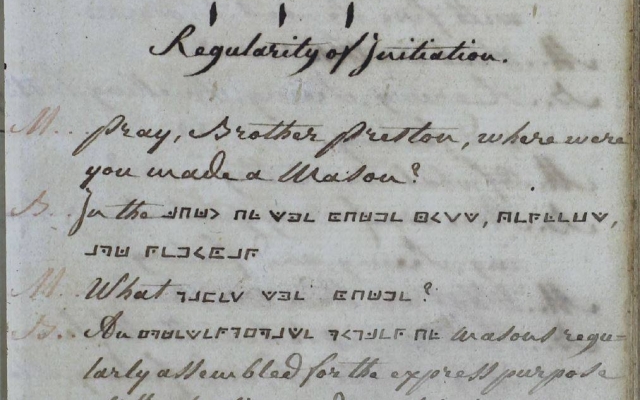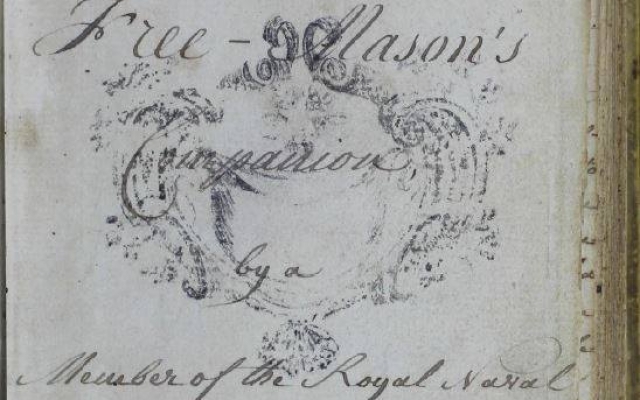Teaser for an upcoming article on William Preston’s Masonic Ritual by Daniel Gardiner
Preston is credited – probably wrongly – with creating the most popular Masonic ritual in England, if not for the entire United Kingdom. His ritual is usually claimed to have been officially adopted by the Moderns Grand Lodge from the early 1770’s on.
For a ritual that is supposed to be nearly universal, and officially adopted, few Masons today (and few in his own time, despite his holding Lodges of Instruction which taught it), have actually seen Preston’s rituals.
In this article, we will examine how many editions of Preston’s rituals are available right now in 2017 to curious readers, other than the few handwritten fragments in a handful of Masonic museums and libraries. We will explore the differences between the Ancients and the Moderns – two competing Grand Lodges in London from the 1700’s that merged in 1813 to form the United Grand Lodge of England. We will also consider how pervasive the rituals written by William Preston really were, because the common wisdom as of today is that his rituals were either the most popular or the most practiced ones, and this may not be true.
This paper gives the transcript of William Preston’s first degree, and a second and third degree that match those known of the Ancients from the 1760’s until the Union of the Ancients and Moderns in 1813.
EXTENT OF PRESTON’S RITUALS’ USAGE
William Preston is frequently credited with being the foremost Masonic ritualist of his time. But how could we know if his rituals were the most widely used? It is difficult to determine how widespread his ritual revisions actually were. Consider what one American Masonic writer tells his audience in 1864:
“[W]e remark, that William Preston began a reformation in rituals, in London, England, about the year 1775. He collected the fragments of the old rituals then accessible, and put them together, and taught them to the Lodges. Within twenty years, nearly all the Lodges in England, Ireland, and Scotland adopted his work, and practically secured uniformity.”
Was every Modern Mason who published a book with an official endorsement inside of it also teaching a ritual that was supposed to be adopted by the Grand Lodge?
There is little to go on regarding the Moderns’ procedures from the 1760’s until nearly 1800. How can we compare what Preston’s ritual system looked like (in its completion, and in versions from about 1800) to rituals from 1730?
We don’t know much about what the Moderns’ rituals look like after Prichard’s book in 1730.
When A.C.F. Jackson printed a book called English Masonic Exposures of 1760-1769, he was following Knoop, Jones, and Hamer’s Early Masonic Catechisms, which covered British ritual from 1696-1730, and Harr Carr’s Early French Exposures, which covered 1737-1751. As neat and tidy as these dates and places are for development, they haven’t been improved by a solid analysis of the 1770’s – 1810’s in England which should show the development of either the Ancients or the Moderns leading up to the Union of both.
So, there are not really many (perhaps any?) reliable examples of the ritual work and lectures used by the Moderns for a period of close to seventy years (1730-1798)!
Is Preston recording the actual work of the Moderns, then? It might be that Preston’s ritual revisions are only his own (lengthy) homage to the Moderns’ rituals.
The later witnesses describing the Moderns’ rituals are:
- The 1798 publication of John Browne’s Master Key, containing only the Questions found in the lectures of the Moderns’ three “Craft” or blue lodge degrees;
- The 1801 Illustrations of Masonry published by Jonn Cole, containing clear English “exoteric” or “monitorial” ritual material (similar but not identical to that of Preston’s Illustrations, Trewman’s Principles, or Webb’s Monitor), but containing nothing of the secret “work” or full lectures;
- The 1801 Masonic Treatise by William Finch, which contained both the Questions and the Answers to the ritual lectures used by the Moderns, as well as clear English “monitorial” or “exoteric” extracts like Cole and the others as well;
- The 1802 second edition of Browne’s Master Key, which, like Finch’s 1801 Treatise, now contained both the Questions and the Answers relating to the lectures as well as clear English “monitorial” or exoteric extracts;
- And finally, William Finch’s 1802 second edition Masonic Treatise, sometimes printed that same year with a name resembling Browne’s, as the Masonic Key – also a Moderns ritual.
When did the Moderns go from the shorter ceremonies of 1730 to the bloated work of Preston?
William Preston is generally believed to have a completed, fully fleshed out first degree presented at the Gala that he threw in 1772 before the Grand Master and guests of the Grand Lodge of the Moderns, and certainly to have all three degrees completed by the second edition of his book in 1775 (his second and third degree lectures were finished 1774). I am not so certain that this means that all three were immediately adopted. But, even if we accept that it they were adopted – William Preston was put on the road to be expelled from the Moderns in early 1778. How quickly was his system of lectures adopted by the Moderns and then spread out to the provinces?
No examples of Preston’s lectures are known to exist prior to around the year 1800 (perhaps as early as 1796, but this is not certain), as was explained at the beginning of this paper. Consequently, it is a matter of speculation as to what Preston’s rituals looked like from 1772 onward. In any event, ultimately, after a years’ worth of efforts, Preston and his breakaway lodge returned to the folds of the Moderns and their Grand Lodge in 1790. Preston’s rare Harodim merged with the regular lodge in 1792.
So again, we should ask, how many lodges were using Preston’s ritual work and lectures? From what date had they begun using them? Did the Moderns Grand Lodge immediately adopt his lectures (all three were not finished until 1774)? If so, how did they handle his expulsion within five years of this? Wouldn’t some of them have felt uneasy at continuing to repeat words and phrases that were (supposedly) written by a man who took over one of the four lodges which it was claimed had formed the Moderns Grand Lodge in 1717?
When Preston – and the people that he convinced to join him in the rebel Lodge of Antiquity – left the regularity of the Grand Lodge authority, they took property with them. This Lodge of Antiquity property was symbolically important, because the Lodge of Antiquity Masons were the successors to the lodge that met in the building where the Modern’s Grand Lodge is supposed to have been founded: the Goose and Gridiron Tavern. Did nobody at all feel uncomfortable rehearsing, every time that the lodge opened, every time that a candidate heard the lectures, words that Preston wrote, knowing that he and his henchmen’s continued unauthorized meeting was a stick in the eye to the Grand Master’s authority? We never read anything at all about this ritual aspect, and yet if Preston’s ritual was the official ritual of the Moderns Grand Lodge, an embarrassment of such enormous proportions as this should have prompted a ritual revision.
Who developed this robust ritual system, and why? We don’t know. I would suggest that it might have come into development as a reaction against the very claims that the Ancients had used so well against them in the 1760’s: that they practiced half the ritual necessary.
Preston’s personal kingdom, the Grand Lodge of England South of the River Trent (which was initiated by his breakaway version of the Lodge of Antiquity), only chartered two lodges.
The system of rituals that Preston practiced at the time of his person Grand Lodge, in the late 1780’s, is known to be very different than those rituals used in the Moderns’ lodges. It is only from 1790 on that Preston returned to the fold, so to speak, and at this point he might then again have begun exercising some real lasting influence on the Moderns’ rituals. Even this is only speculation.
As the unification between the Ancients and Moderns neared, in 1809 the Moderns created a special Lodge of Promulgation, whose purpose was to bring its ritual forms closer in line with those of the Ancients’.
The story that the Moderns’ ritual work and lectures were universally (or near so) Preston’s, then, might date to this time. Dyer again: “[I]t would not be unfair to say that the Special Lodge of Promulgation was ‘Antiquity’ dominated… It must be a fair assumption that the new standard practice for Craft degree use under the premier [Modern] Grand Lodge was very much based on the system of William Preston.”
If Preston’s rituals (pre-Harodim) were the rituals adopted by the Grand Lodge of the Moderns, then its been mostly overlooked that they went from very bare-bones ceremonial work of conferring the degrees and giving lectures, to one that was literally several hours longer. This doesn’t seem to have been the case. It is probable, though, that as the Moderns saw a merger with the Ancients as inevitable, that when they had to bring a ritual to the table, they wanted to look good, and use the most well-known and elaborate one available as a starting point. The Grand Stewards’ Lodge (the most elite Moderns lodge following the Lodge of Antiquity’s scandal) would have begun trimming this ritual, but keeping the best parts, for eventual presentation.
COMPARING PRESTON’S FIRST DEGREE WITH THE ANCIENTS’
It should be pointed out that if the Ancients were supposed to be more developed in their ritual work and lectures than the Moderns, you wouldn’t know it by comparing the exposures from the 1760’s (which are those of the Ancients) with the rituals of the Moderns from 1798-1802 printed by Finch and Browne.
The opening and closing ceremonies in works like Three Distinct Knocks and Jachin & Boaz are readily found online, and in many reprints and original editions in professional and private Masonic libraries, and should be compared with that given in the ritual in this paper. A comparison of this with the “first version” of the Entered Apprentice degree opening ceremonies printed by P.R. James in AQC should make it clear that they bear a superficial similarity in style, but that even this incomplete “first version” Preston ritual is more developed than that in Jachin & Boaz, and the “third version” more so. To put a fine point on it: the Moderns had not only caught up with the Ancients ritually by the period 1798-1809 (if not earlier); they had surpassed them – as far as the surviving records show. This leaves room for further study and a reassessment of both Grand Lodges in terms of ritual.
This paper provides an opportunity to compare William Preston’s Entered Apprentice degree (Moderns) against – in the same handwritten manuscript – the Ancient’s Fellow Craft and Master Mason degrees.






